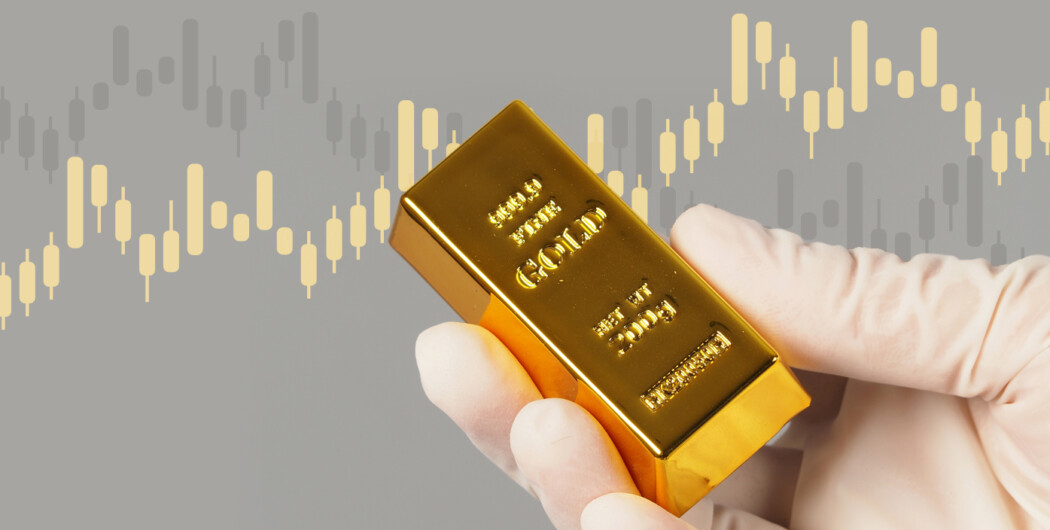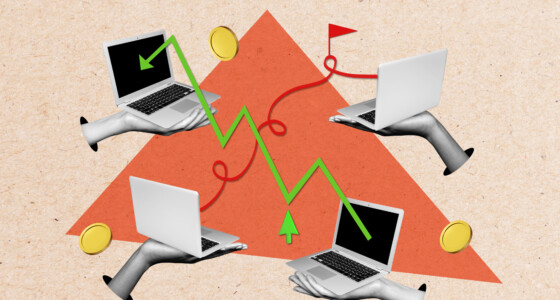

Are you looking to diversify and add some shine to your investment portfolio? Gold ETFs are a popular choice for investors hoping to capitalize on the rising demand for the precious metal. These assets first emerged in the early 2000s, and by March 2023, the global gold ETF total assets under management had risen to $220bn.
An interesting fact about gold: the largest gold nugget ever found was called the Welcome Stranger. It weighed a whopping 78 kilograms and measured 61 centimeters in length and 31 centimeters in width, so it had to be broken into three pieces for shipping.
But let’s get back to the gold ETFs: should you trade them? The answer ultimately depends on your personal investment goals and risk tolerance.
What is a gold ETF?
ETFs build a bridge between real assets and financial assets.
How do gold ETFs work? ETF is an exchange-traded fund and an investment vehicle that tracks the price of gold. It operates like a mutual fund or index fund, but it holds physical gold or gold derivatives instead of a portfolio of stocks or bonds.
The goal is to replicate the performance of the underlying asset, i.e., the price of gold.
If the price of gold goes up, the value of the ETF generally increases as well. The opposite also tends to be true: gold goes down, and so does the ETF. Although, it’s important to note that the performance of a gold ETF doesn’t rely on gold alone (more about that in a minute).
This asset type offers greater flexibility, liquidity, and transparency than traditional methods of investing in gold. In contrast, buying gold coins or bars requires storage and insurance costs, and selling it may also be difficult.
How to trade gold ETF: CFDs
CFDs (contracts for difference) are one of the simplest trading instruments for gold ETF CFD trading. This process involves buying and selling contracts that represent the performance of a gold ETF without owning the underlying asset itself. It’s like an additional layer that allows investors to trade on the price movements of an asset without actually owning it. Here, the asset is the gold ETF.
The convenient thing about gold ETF CFDs is that they trade like traditional assets. Meaning that they are bought and sold on online trading platforms or through a broker. Traders can monitor their positions as they usually would in real time and adjust their trades accordingly. Just make sure your broker offers these assets before signing up (if you’re planning to trade gold ETF CFDs, of course).
If you expect the price of the gold ETF to rise, buy a long contract to potentially profit from the price increase. If you think it’ll fall, go for a short contract to capitalize on the decrease.
As CFDs are a leveraged product, you can trade with a smaller amount of capital compared to investing in the underlying gold ETF directly. However, this also means that the potential losses can be magnified as well.
Gold ETFs and gold ETF CFDs
Just to avoid any confusion going forward, let’s draw a distinction between gold ETFs and gold ETF CFDs:
- Ownership – When you buy a gold ETF, you own a portion of gold held by the fund (applicable for physical gold ETFs). With a gold ETF CFD, you only trade on the price movements.
- Fees – ETFs usually have management fees, while gold CFDs have commissions and spreads charged by the broker.
- Objectives – ETFs are typically held as long-term investments to hedge against inflation, diversify a portfolio, or as a store of value. Gold ETF CFDs are popular short-term trading assets.

Types of gold ETFs
From funds that invest solely in physical gold to those that focus on mining companies, the world of Gold ETFs is vast and varied:
Physical gold ETF
It’s important for investors to note that not all gold ETFs are created equal — nor do they all invest exclusively in gold bullion — and investors should carefully review the holdings to determine how much of the ETF’s portfolio is invested in physical gold.
Physical gold ETFs invest in physical gold bullion or coins, and their shares represent ownership in the underlying gold. These are often what people are referring to when they talk about gold ETFs.
Gold miners ETF
Gold miners ETFs can be an interesting option for those who are bullish on the gold mining industry, as they provide exposure to a portfolio of gold mining companies. Keep in mind that gold miner ETFs are subject to a different set of risks than physical gold ones.
Inverse gold ETFs
These assets are unique in that they provide returns that are the opposite of the price of gold. Therefore, they serve as hedging tools.
Leveraged gold ETFs
Leveraged ETFs are designed to amplify the returns of the underlying gold. By using financial derivatives like futures contracts, these ETFs provide the potential for higher returns in a shorter period of time (unfortunately, the potential for higher risks, too).
Factors that affect the performance of a gold ETF

Here are some of the top factors that can affect the performance of a gold ETF:
- The price of gold – Any changes in the price of gold will directly impact the performance of the ETF. If the price of gold increases, so will the value of the ETF, and vice versa.
- Market conditions – Keep your eyes on interest rates, inflation, and economic growth. For example, if interest rates are low and inflation is high, investors turn to gold, driving up its price.
- Supply and demand – If there is a shortage of gold, this would benefit the ETF.
- Currency fluctuations – Gold is often priced in US dollars. So if the US dollar weakens, the ETF will be quoted higher.
- Geopolitical events – Wars, political instability, or natural disasters can all increase demand for gold as a safe-haven asset.
How to analyze gold ETF prices
One of the key steps in analyzing gold ETF prices is tracking their performance over time. This gives no guarantee of future performance, but it does help identify patterns and trends, as well as potential entry and exit points.
Technical analysis tools can also be helpful – specifically, moving averages, RSI, Bollinger Bands, and MACD. These tools will help you identify potential support and resistance levels and determine when to buy or sell. To make a comprehensive assessment, you should also consider fundamental factors, some of which are listed in the previous section.
With so many gold ETFs available in the market, it can be challenging to know which ones to choose or even which ones to analyze first. To help you out, here are some of the top gold ETFs based on assets under management:
- SPDR Gold Shares (GLD): the largest and most popular gold ETF, over $60 billion in AUM, over 7.5 million shares in average volume
- iShares Gold Trust (IAU): close to $29 billion in AUM, over 5.4 million shares in average volume
- SPDR Gold MiniShares Trust (GLDM): over $6 billion in AUM, over 1.3 million shares in average volume
- Aberdeen Standard Physical Gold Shares ETF (SGOL): close to $3 billion in AUM, close to 2.5 million shares in average volume
Conclusion
Gold ETFs can be a valuable addition to an investor’s portfolio. It provides exposure to the precious metal without the hassle and expense of owning physical gold. But, as with any investment, you should carefully consider the potential risks and rewards. Factors like price volatility, liquidity, and currency fluctuations can all impact the value of these funds, so do your due diligence and never purchase assets that you don’t understand.
Sources:
Gold ETF Flows: March 2023, World Gold Council
Gold ETF list, VettaFi







